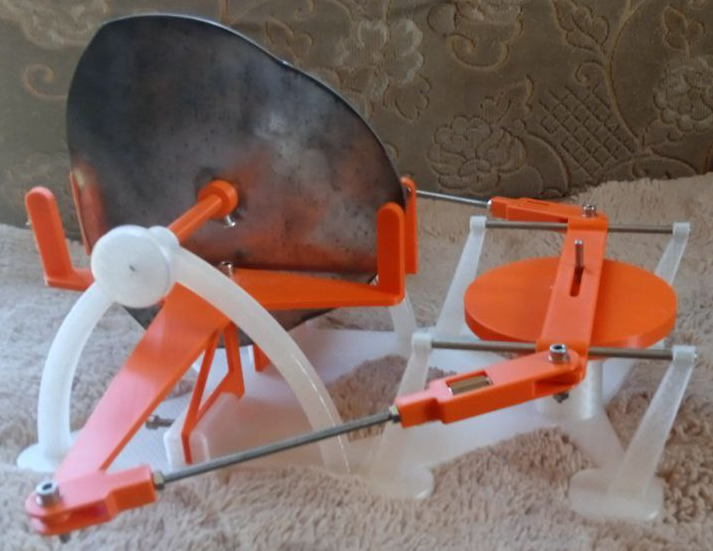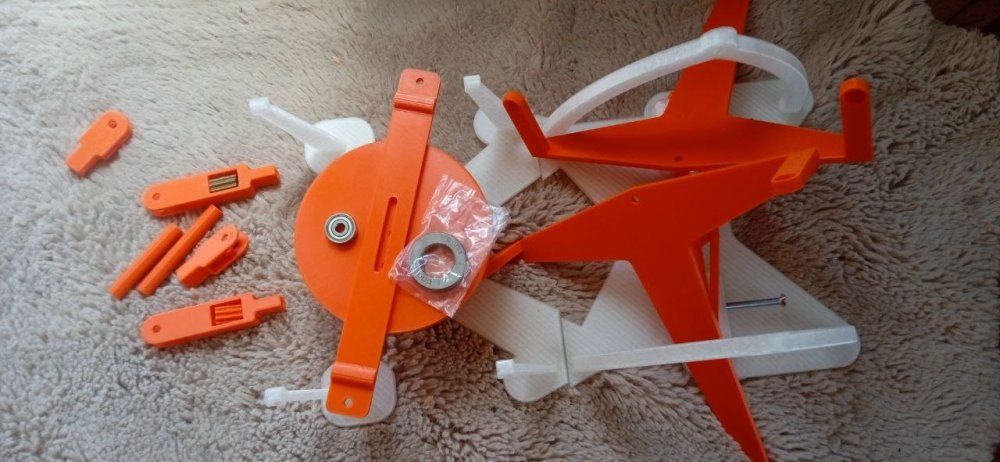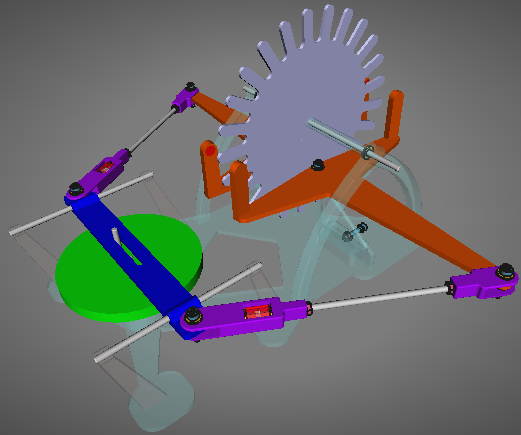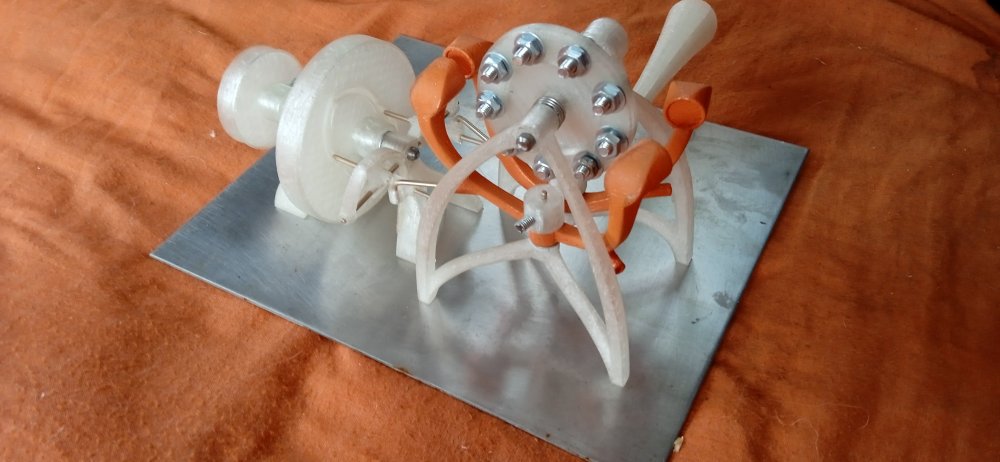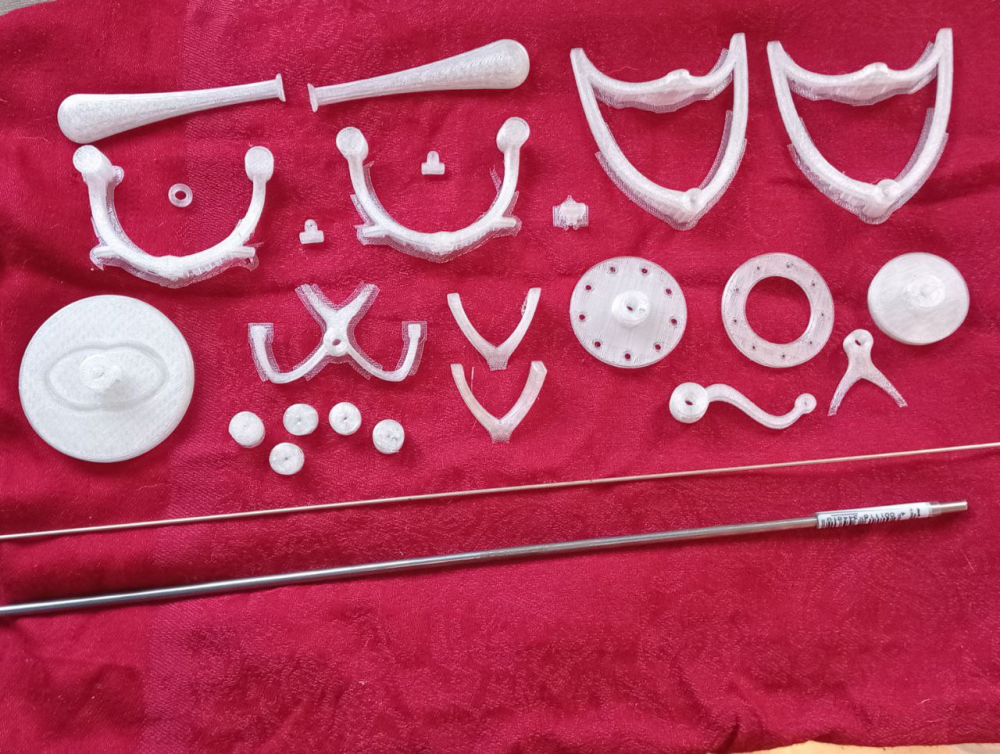-
Posts
78 -
Joined
-
Last visited
Content Type
Profiles
Forums
Events
Everything posted by Prajna
-
Yes, Portugal. I had rather hoped that the adjacent magnet pairs would supply the torque to overcome the drag and, while they have the most advantageous vector to the track, they are more distant than the pair that have a departing tab and, as we know, the field drops off by inverse square, so their contribution may not be much. I do Solstice rather than Christmas but, "Boa Festas", as they say over here.
-
Hi @exchemist, yes, I have the device built and yes, as someone hinted, there is a sticky point where the tab is pulled back towards the magnets that I rather hoped would be overcome by the adjacent pairs of magnets. It's been a long, slow road, made longer by the intervention of olive season, having to rebuild and reengineer my water system, waiting for filament, etc, but I am still working on it. I have next to reprint an assembly jig that will help me to align and adjust the tabs so that I can change where they are in relation to the cam track. There is still a poor level of accuracy in the printed parts and thus the mechanism is a bit janky with too much friction, however it does let me get a feel for where the forces are exerted at different points in the rotation. My feeling from the current setup is that it will not do as I had hoped and likely - if it was constructed perfectly - all vectors would balance and the arrangement would neither drive nor drag. At present it drags, at least when a tab is exiting the magnetic gap. I will print up the new jig and adjust the tab alignment and see how it feels but I suspect I will just be advancing/retarding where the sticky point occurs. I've not completely given up on exploring the idea but I am not as optimistic as I was.
-
Perhaps you have never heard of Clement Figuera. He was big news and reports about his Infinite Energy Machine were published in the New York Times, several London newspapers, Germany and, of course, Spain (since he was Spanish). He was the kind of crackpot who was rose to the rank of Inspector of Forests in Spain. It seems he was 'big news' at the time but sadly he died shortly after getting involved with bankers to develop his machine. Certainly, in the 100 odd years since his death nobody seems to have been able to recreate his device and I'm sure you guys all know much better than the scientists of the time now but it was 'big news' then. Take a look back at my first few posts in this topic and indicate the basis of your assertion that I "show[ed] up making assertions". I pointed out some rudimentary and uncontroversial aspects of magnets, sure, but I asked a question rather than asserting any claims of being the first to invent a free energy or perpetual motion machine. Try analysing how I presented the subject compared to how you all reacted. It's telling. Maybe not to physicists because you inhabit a cosy paradigm where the basic assumptions are virtually unassailable and you can quickly dismiss even evaluating anything that may contradict any of the foundations upon which that paradigm is constructed. You do pay lip service to the idea that nothing is fixed in science and that even the central laws can be challenged but really you share Lord Kelvin's certainty that everything of importance has already been discovered and there is only the mopping up of a few minor details to be done. Y'all may be right about everything but you are not a nice bunch of people to engage with. Or it means that my bent is engineering rather than maths or physics and that I tend to approach problems from that angle, not that I'm lazy or lack knowledge. I have, since March, taught myself 3D Cad and 3D printing to a level of respectable competence and I am quite capable, though not particularly inclined, to learn whatever is needed to address this subject from a maths and physics angle, if that proves necessary. The respondents in this topic have demonstrated sufficient of their own shortcomings that are rather less becoming than nescience or laziness.
-
And that's not arrogant, @exchemist? It's certainly not friendly or helpful. I engage on a number of forums and they are generally friendly. Posting on this topic on an engineering forum I have come in for a certain amount of gentle ribbing and one or two who were less polite and seem to share your convictions, but there have also been many helpful and supportive responses. You are one of the few people on this forum who has offered helpful insights, thank you for that. You believe that nobody has demonstrated one. You can not know (unless you claim omniscience) that nobody has ever demonstrated one unless you know (omniscience again) for sure that it is not possible. Do you know for sure that it is not possible? Is science, as we have defined it, over? At the very least you people are dismissive. Not having had any helpful analysis here I will simply continue my design and construction until I satisfy myself that it doesn't work, if that turns out to be the case, or things turn out far more interesting than you can imagine. Either way I will have a deep understanding of something interesting - I did say that it is a curious device and I'm curious and I can't understand why none of you are.
-
I've added the following to my web page about the device: But will it work? Well, we don't know yet. I have to finish building it so we can see. I have about one more day of 3D printing parts and still have to find suitable magnets. Also I would rather use 5mm stainless or chrome rods but may have to settle for mild steel rods if I can't find a local source for something better. Most of the magnetic forces work in the direction we want them to but there is a point, as the metal tab is leaving the magnetic gap, where, in addition to the repulsion vector, which works in our favour, there is a magnetic drag on the tab, trying to drag it back into the gap. At this point the magnets are quite close and it's not easy to work out which force vector will win the tug-o-war but at this same time there are two adjacent pairs of magnets - one pair in attraction and increasing their force and the other pair in repulsion with their force diminishing - that are exerting their force in a helpful direction and they may help to overcome any back-attraction of the closest magnets. I had rather hoped that someone on one of the science forums I posted to might take a look at the geometry of the device and give some pointers as to how the force vectors will balance but it turns out, in my experience anyway, that the denizens of such fora are a sarcastic, arrogant and unfriendly lot when it comes to examining such a device; probably they feel that since free energy/overunity/perpetual motion is outlawed by thermodynamics it is not worth their time nor worth the risk of tarnishing their professional reputations. So we'll just have to build and test it ourselves.
-
The details are up on my site and I've just set up a repo for the Mk2 with control mechanism: https://github.com/prajna-pranab/SFMM-Mk2
-
I've updated the web page for the device detailing the control mechanism that allows the device to be started in forwards or reverse rotation and to be stopped when running. (Just in case anyone is interested.) I'm rather pleased with the way it has turned out and has fitted into the device and I think it is worthy of a patent by itself (if I was into patenting.) The control system toggles the device off whether it is rotating forwards or backwards, is simple and has few moving parts. Info at https://tomboy-pink.co.uk/sfmm/
-
Indeed, I consider it at least intriguing but I think it is worth trying to incorporate vector force indicators in the simulation - showing the force and direction at each bearing to get some idea of whether there is a net rotary force on the rotor. Obviously, there will be maximum attraction and repulsion when the magnets are closest (due to the inverse square law) but at that point the cam track is pretty much perpendicular to the force. At that same point the adjacent pairs of magnets will be in the middle of their travel and exerting force at a convenient vector but their strength will not be so much because of their spacing, the opposite pair are facing a perpendicular track and at their most widely spaced. It should be possible to at least approximately calculate the vectors if we know the power of the magnets and their position and the dimensions of the tabs. Probably a FEM analysis would do it but I'm not really familiar with FEM modelling. I should have a 3D printer next week or possibly the week after, so can start building. I have also had a think about speed control and stopping the machine once it is running. The tabs are lined up more or less with the positions where the tracks converge (will probably need some adjusting where the flux switching happens), so by mounting those tabs on their own disc the disc could be rotated to align the tabs with the 'V' where the tracks converge and diverge again. That would stop the device. If the tab ring was rotated further, so that the tabs are aligned to the diverging sections rather than the converging ones then the device should run backwards. Perfect alignment of the tabs will ensure maximum power from the device and anything but that should slow or stop the device. It can be arranged easily enough with something like a slot with an eccentric cam that can be squeezed to cause the tab ring to rotate relative to the cam tracks.
-
I won't attempt to directly answer your question but something you might like to investigate, which is related, is a much under-recognised sense we have called proprioception (if that's how it's spelt - my spellchecker also 'under-recognises' it.) This sense is not the sense of touch - which we are all familiar with - but the internal sense of e.g. where our limbs are in relation to our body. I hope you will find that an interesting study. I would say that we certainly sense pressure: you can easily distinguish between a gentle and not so gentle push, for instance.
-
Development continues but now I am looking at something quite different. In trying to improve the SFT I have come up with an idea that employs the same principle I have been using in the SFT designs but it operates (if it operates at all) in a different way. Here's a model to examine: That is looking from one side of the device and only shows one pair of carriages. The following image displays two pairs and labels the parts: What you're looking at is a cylinder with two opposed sinusoidal cam tracks running around the sides and slider rods that support carriages carrying a magnet and a bearing each. The carriages can slide up and down the slider rods and the bearings constrain the carriages to follow the cam tracks. The magnets are fitted in the carriages so that like poles are opposed on each pair of carriages. There are ferromagnetic tabs (soft iron or transformer laminations) arranged around the centre of the cylinder at each point where the opposite cam tracks are converging and gaps between the tabs wherever the tracks are diverging. When the cylinder is rotated such that the magnets on one side are closest there is no iron in the gap between them, so the magnets repel, imposing a vector force on the cam tracks that causes the cylinder to rotate to the left. The magnets on the opposite side will be at their maximum separation but they also then encounter a tab in the gap and will be attracted to the tab rather than their fields opposing, thus imposing a vector force on the cam track that also causes the cylinder to rotate to the left (because there the tracks are converging.) A further two sets of carriages should be arranged on the adjacent axes for smoother rotation, to increase power and to provide some assistive thrust when the vectors of the adjacent magnets are aligned to the cylinder axis at the peaks and troughs of the sinewave, (i.e. one set facing you and the other set at the back of the cylinder.) There are five peaks in the sinewave of the cam tracks, so on either side of this image the magnets will be at opposite extremes of their travel, one set pushing and the other pulling. The front and rear sets of carriages will be in an intermediate position, still with one set pushing and the other pulling. The closest magnet pairs will exert the most force (due to the inverse square law) and there will always be one pair of magnets exerting a strong repulsion (or strong attraction.) Hopefully that is enough info to describe the device.
-
Well, the SFT-Mk5 is all assembled but sadly it is not rigid enough. I'm hoping that if I beef up the supports for the bellcranks that might make it stiff enough to work. The problem at the moment is that the magnets stick to the rotor and the mechanism is supposed to limit their travel so that can't happen but there is too much movement in the bellcrank mounts and that lets the magnets get too close to the rotor. Oh well, iterative process.
-
The parts are all printed. I just have the rotor to make. I was going to get my previous design water jet cut but I have redesigned it so that it is easy for me to make with the tools I have.
-
Ah, well I was not so much wanting an answer as hoping for one. I would have thought that a rough answer could be approached by working with the strength of the magnets - N58 10mm x 3mm - and choosing an arbitrary thickness of the fingers, say 1mm, assume the area of the finger in the gap is the same as the area of the magnets, the gap varies between a couple of mm (just so it doesn't reach the finger) and 40mm. But maybe it is much more complicated than that, even for a rough estimate. Sure, there is the overriding law of thermodynamics, dogma++, as it were, that says that one way or other the forces must be balanced but science is about heresy and challenging dogma. In fact, that about sums science up: it is the recorded history of stuff we were certain of but was then successfully challenged and overturned. When we treat science as religion and refuse to even test things because dogma then we get stuck. I realise that scientific laws are even more sacrosanct dogma than theories and hypotheses but there is a small possibility that energy enters the system by some as yet unidentified means and I am not convinced that we have yet fully understood magnetism. Who was it, a member of the Royal Society, who said, back in the 1800s, that we understood all of physics and there were only a few minor details to nail down? I have done a few rough and ready experiments with magnets and sheets of iron, which is where my (perhaps naive) optimism comes from. It seemed to me, and to someone on an engineering forum who did his own experiments, that interjecting a sheet of steel in the magnetic field 1. collapsed the repulsive field causing the magnets to be attracted towards the sheet and, 2. didn't feel to have much in the way of eddy current drag. Maybe physicists understand magnetism at the level of electrons but I'm not convinced many of them have actually picked up and played with them. For all that the field is supposed to be well studied I recently watched a video with Joe May, the inventor of the Joe Cell, who demonstrated some astounding effects with a ring magnet that had been broken apart. Perhaps there is more to know and perhaps there is a way to use the magnetic field as something more than a spring. Because I have no other means, short of some serious study of physics, for me to evaluate the forces in this system I will just carry on developing this prototype and test it. Anyway, empirical evidence is the most convincing. It may (certainly will, according to most of the assessments I have seen) turn out that this is but a very good example to show how 'free energy' is impossible and the laws of thermodynamics are as certain as the law of karma, or perhaps this device will produce more output than what we input by way of the rotor and still not break the laws of thermodynamics (because we might identify where the extra power is coming from). In any case I will end up with an interesting device even if it is just a curiosity. Thanks for your interest and I will certainly keep the forum updated with my results.
-
Hey, thanks for the response and your clear examples. In my view it boils down to a simple question: is the eddy current drag in the metal fingers more than, less than or equal to the energy captured by switching the magnetic flux? I had rather hoped, in posting here, that someone might be able to calculate (or even have an intuitive sense of, what that eddy current drag might be and how it might compare to the forces induced in the Bellcrank by the opposed magnets. There will, of course, be other losses in the system but I am interested to know the answer to the drag Vs magnetic forces in this system. It's all very well illustrating the principles with examples but here we have a simple example that could be analysed and the results would be an explanation on their own. In any case, I have one more day of 3D printing to do and some water jet cutting to arrange and I will be able to assemble and test the device. For the present the rotor is only a first best guess - I may need to change the size of the fingers or thickness to contain enough of the field to switch the flux sufficiently, but we shall see. Thanks again.
-
Bigger and better, easier to print, stiffer transmission, looks a bit like the Millennium Falcon, ...
-
Sadly, I need to redesign. At this scale it is very difficult to get the tolerance needed to get this design to work. Also I need to design in adjustment for lining things up. The crank mechanism, whilst beautiful and good in theory is not ideal in practice, so I'll use a much simpler Scotch Yoke system to convert the reciprocal motion to rotary motion.
-
It's like an Airfix kit. I have some cleaning up of supports to do and reaming out some holes for various shafts:
-
Off to pick up my 3D printed parts tomorrow!
-
A poundal is the certain force - or so my dictionary reckoned - to accelerate a pound of weight by one foot per second per second. (written some years ago)
-
A little update: yesterday I went to visit my local FabLab to dicuss getting some support from them. The guy took one look at the model and said, "Oh yeah, we can print that easy," which is rather reassuring, since I've never 3D printed anything and this is the first time I've designed for 3D printing. The FabLab have an event all this week, so are a bit busy, but I have emailed the lab manager and hope to get an appointment to go and discuss the project early next week. Meanwhile, in case anyone fancies getting in ahead, the full project is hosted on my GitHub (referenced above) so you can download and experiment. There are still a few issues with render materials that I am working on with the Render Workbench developer but otherwise the model should be pretty much ready to work with.
-
I have some 10mm X 2mm, I think N52, suitable for this device.
-
Hmm, maybe you can do it with iron nitride magnets. They can be manufactured and then magnetised in place. You'd need an expensive printer to print the shafts, axles and fingers too (I'm planning to get them laser cut).




